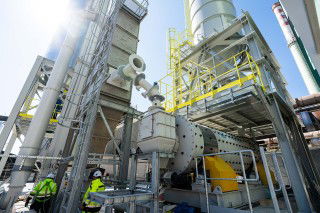This week Ecocem spoke out on the UK Government's measures for CO2 reduction for new homes and buildings. The aim of reaching net-zero carbon emissions in the construction sector will need not only energy-efficient buildings but improved sustainability throughout the lifespan of a building. Ecocem and others are calling for the reduction of the embodied carbon from emissions during the complete process of construction of a building and its materials’ lifetime to be taken into consideration.
Embodied carbon emissions account for 40-50Mt of CO2 emissions annually in the UK, says the UK Green Building Council (UKGBC). Engineering company Arup has calculated that around 50 per cent of the whole-life emissions of a building could come from the carbon emitted during the construction and demolition process.
"Embodied carbon is particularly significant in construction, as the production of steel and cement makes up between 16 and 18 per cent of global CO2 emissions annually," reports law firm Shoosmiths. “There are currently no mandatory UK limits on how much embodied carbon can be emitted during the construction process."
Following the introduction of Duncan Baker's private member's Bill in February 2022, which sought to monitor and limit embodied carbon emissions in construction projects, the need for a better measure of carbon emissions has been gaining momentum. The Part Z Bill would have made amendments and created the UK's first legislation requiring the measurement of embodied carbon, but Duncan Baker MP did not pursue his bill any further. The bill would have set mandatory limits for embodied carbon emissions on all building projects over 1000m2 from 2027, requiring builders to assess and report on the whole life carbon on non-residential projects over 1000m2 from 2023 and all residential projects from 2025.
Incorporating embodied carbon into net zero targets
The UK Building Council's Net Zero Whole Life Carbon Roadmap of 2021 recommends the regulation of embodied carbon for new buildings and major refurbishments. However, the roadmap recognises that embodied carbon is currently only a voluntary assessment while it recommends introducing limits for it across all sectors by 2027.
Furthermore, the UK Climate Change Committee's latest progress report to Parliament called for 'mandatory whole-life carbon reporting followed by minimum whole-life standards for all buildings, roads and infrastructure by 2025.'
In February 2022 the UKGBC calculated that housing developers could achieve 20 per cent embodied carbon reduction across low-rise residential developments through simple master-plan level design interventions. UKGBC also recommended that the government set out a trajectory for rightening regulations, so that by 2030 all new buildings operate at a net zero carbon for regulated and unregulated energy including embodied carbon.
The need for more energy-efficient housing
The UK Government plans to build 300,000 new homes a year by the mid-2020s but recognises that 16 per cent of the UK's greenhouse gas emissions already come from existing UK homes. Future homes must be more energy-efficient and sustainable. However, housing emissions were only cut by 1Mt CO2 equivalent between 2018-19.
The Future Homes Standard to be introduced in 2025 and will ensure that new homes will produce 75-80 per cent less carbon emissions than homes delivered under current regulations.
Data gathering continues
The obstacles to the UK Government taking further action now appear to be around its need to continue engagement with industries on embodied and whole-life carbon, and its belief that large and small developers still consider embodied carbon ‘unfamiliar territory’. Moreover, the Climate Change Committee's 2019 report "UK Housing: Fit for the Future?" Recommended that there was no easily accessible source of 'whole-life' cost information to allow a simple comparison between the cost of green infrastructure solutions (timber) and traditional grey infrastructure solutions (concrete and steel).
The Global Cement and Concrete Association (GCCA) says that cement and concrete can play a major role in building a sustainable world tomorrow. Cement producers making low-carbon products would benefit from embodied carbon regulations as cement and concrete act as a carbon sink for many years once they are incorporated into buildings.
In June 2022 The Environmental Audit Committee's "Building to net zero: costing carbon in construction" sets out clear actions and recommendations for the UK Government to reach net zero. However, it also stated, "if the UK continues to drag its feet on embodied carbon, it will not meet net zero or its carbon budgets."
